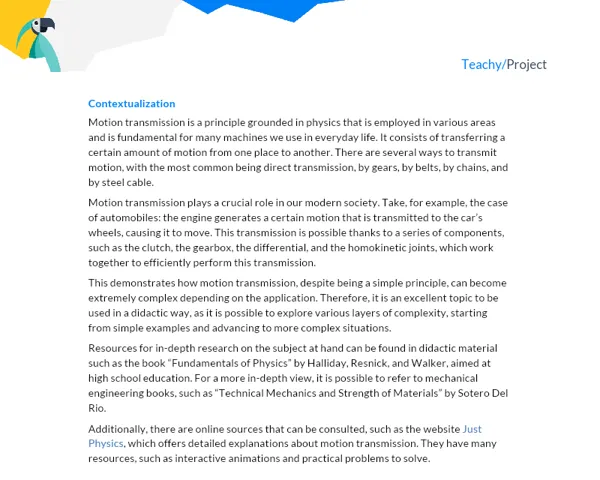Contextualization
Since the dawn of civilization, humans have observed and experienced the effects of electricity, whether through lightning in the sky or even the shock of an electric eel. However, for a long time, electricity remained a mystical and inexplicable phenomenon. It was up to science, therefore, to reveal the secrets of this incredible phenomenon and transform it into one of the foundations of the modern world.
To begin, it is important to keep in mind the central concept of our project: electric potential energy. It results directly from the interaction between electric charges, being a form of energy that is associated with the positioning of charges in relation to each other. When, for example, we move two charges that attract each other apart, we perform work that results in an increase in the electric potential energy of the charges. This concept, although somewhat abstract, is essential to understand everyday phenomena, such as the operation of a cell phone or an electric car.
Electric potential energy and electric field are intrinsically linked. The electric field is the space around an electric charge where the action of that charge on others occurs. In addition, the electric potential energy depends directly on the electric field generated by the charges. Therefore, without understanding the electric field, it is not possible to fully understand electric potential energy.
Electricity is a prime factor in modern life. Everything around us, from the device we use to communicate to the household appliances that make our lives easier, depends on electricity to function. This is why it is important to understand how electric potential energy works. It is the basis for the generation and storage of electrical energy, being crucial for the evolution of technology and production processes. In addition, electric potential energy is of fundamental importance in the health field, allowing the operation of complex and sophisticated medical equipment.
Understanding this phenomenon not only helps us understand how the world works, but also opens up avenues for technological innovations and creations that can positively impact our lives and society as a whole. By mastering these concepts, we will be able to propose more efficient and sustainable solutions to current challenges.
To delve deeper into the subject, you can use the following resources:
- Book "Physics Vol. 3" by Tipler, P. A. and Mosca, G. (Ed. LTC)
- Khan Academy: Electric Potential Energy
- Brasil Escola: Electric Potential Energy
Remember that these are just starting points. You are encouraged to seek out and explore other reliable resources to further your studies!
Practical Activity: Power Transmission Line Project
Objective
The objective of this project is for students to apply the concepts of electric potential energy and electric field in the construction of a scaled-down power transmission line. They will create a simplified mathematical model that can predict the behavior of the transmission line and design an energy storage system.
The project will also involve the discipline of Mathematics when working with equations, geometry and statistics during the development of the mathematical model.
Project Description
Groups of students will design, build, and test a scaled-down power transmission line. They will also mathematically model the behavior of their system in order to predict energy flow, energy loss, and energy storage. To do this, they will consider the following aspects:
- Electric potential energy: How is energy transferred and stored in your system?
- Electric field: What is the electric field at different points on your power transmission line and what does this indicate about the potential energy and energy efficiency of the system?
- Mathematical modeling: How can you use mathematics to describe and predict the behavior of your system?
After completing the project, students will write a detailed report on their work. The report should include the theoretical details of the concepts involved, the description of the activity, the methodology adopted for the project, and the results obtained.
The materials needed for the project will include magnets, conducting wires, metal plates, 9V batteries, PVC pipes, ruler, calculator, and materials to build the transmission line support (such as cardboard, glue, and tape).
Project Step by Step
- Theoretical and Strategic Study (approximately 4 hours): Students should first seek to thoroughly understand the concepts of electric potential energy and electric field, their relationships, and how they influence the transmission of electrical energy. At this stage, groups should develop a strategic plan for the construction of the power transmission line, taking into account the available materials.
- Model Construction (approximately 5 hours): Students will build the power transmission line model based on the developed strategic plan. Each group will document the entire construction process, including the problems faced and how they were solved.
- Testing and Observations (approximately 3 hours): The groups will test the power transmission line, observe and record the behavior of the model. They should measure the energy transferred, the energy lost, and the energy stored by the system, in addition to observing the electric field at different points on the transmission line.
- Mathematical Modeling and Analysis (approximately 6 hours): With the data collected in the previous step, the groups will work on building mathematical models that describe the behavior of their power transmission line. These models will be used to predict future behaviors of the system.
- Conclusions and Report Writing (approximately 7 hours): Finally, each group must compile all data, observations, and results into a report. The report should follow the suggested format: introduction, development (including the theory used, detailed description of the activity, and methodology), results obtained, and conclusions. It should also include the bibliography used by the group.
In this way, students will have a complete project, ranging from theory to practice to the writing of a complete report. This project will allow a deeper understanding of the concepts of electric potential energy and electric field, in addition to developing important skills such as time management, communication, problem solving, creative thinking, collaboration, and proactivity.


